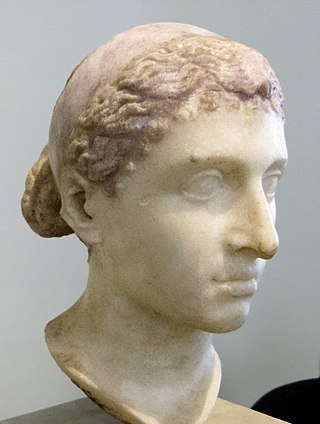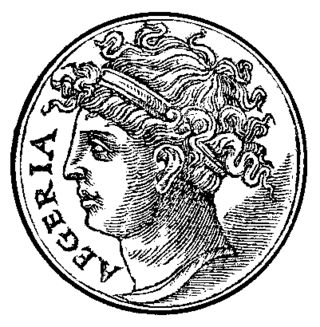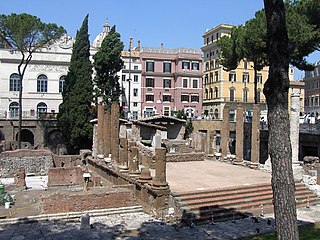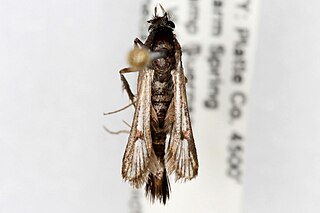Related Research Articles

Venus is a Roman goddess, whose functions encompass love, beauty, desire, sex, fertility, prosperity, and victory. In Roman mythology, she was the ancestor of the Roman people through her son, Aeneas, who survived the fall of Troy and fled to Italy. Julius Caesar claimed her as his ancestor. Venus was central to many religious festivals, and was revered in Roman religion under numerous cult titles.

Isis was a major goddess in ancient Egyptian religion whose worship spread throughout the Greco-Roman world. Isis was first mentioned in the Old Kingdom as one of the main characters of the Osiris myth, in which she resurrects her slain brother and husband, the divine king Osiris, and produces and protects his heir, Horus. She was believed to help the dead enter the afterlife as she had helped Osiris, and she was considered the divine mother of the pharaoh, who was likened to Horus. Her maternal aid was invoked in healing spells to benefit ordinary people. Originally, she played a limited role in royal rituals and temple rites, although she was more prominent in funerary practices and magical texts. She was usually portrayed in art as a human woman wearing a throne-like hieroglyph on her head. During the New Kingdom, as she took on traits that originally belonged to Hathor, the preeminent goddess of earlier times, Isis was portrayed wearing Hathor's headdress: a sun disk between the horns of a cow.

Jupiter, also known as Jove, is the god of the sky and thunder, and king of the gods in ancient Roman religion and mythology. Jupiter was the chief deity of Roman state religion throughout the Republican and Imperial eras, until Christianity became the dominant religion of the Empire. In Roman mythology, he negotiates with Numa Pompilius, the second king of Rome, to establish principles of Roman religion such as offering, or sacrifice.

Cleopatra VII Thea Philopator was Queen of the Ptolemaic Kingdom of Egypt from 51 to 30 BC, and its last active ruler. A member of the Ptolemaic dynasty, she was a descendant of its founder Ptolemy I Soter, a Macedonian Greek general and companion of Alexander the Great. After the death of Cleopatra, Egypt became a province of the Roman Empire, marking the end of the last Hellenistic-period state in the Mediterranean and of the age that had lasted since the reign of Alexander. Her first language was Koine Greek, and she was the only known Ptolemaic ruler to learn the Egyptian language.

In ancient Roman religion, Ceres was a goddess of agriculture, grain crops, fertility and motherly relationships. She was originally the central deity in Rome's so-called plebeian or Aventine Triad, then was paired with her daughter Proserpina in what Romans described as "the Greek rites of Ceres". Her seven-day April festival of Cerealia included the popular Ludi Ceriales. She was also honoured in the May lustration (lustratio) of the fields at the Ambarvalia festival: at harvest-time: and during Roman marriages and funeral rites. She is usually depicted as a mature woman.

In Roman mythology, Evander was a culture hero from Arcadia, Greece, who was said to have brought the pantheon, laws, and alphabet of Greece to ancient Italy, where he founded the city of Pallantium on the future site of Palatine Hill, Rome, sixty years before the Trojan War. He instituted the festival of the Lupercalia. Evander was deified after his death and an altar was constructed to him on the Aventine Hill.
In ancient Roman religion, Antevorta was a goddess of the future, also known as Porrima or Prorsa. She and her sister Postverta were described as companions or siblings of the goddess Carmenta, sometimes referred to as "the Carmentae". They may have originally been two aspects of Carmenta, namely those of her knowledge of the future and the past.

Bona Dea was a goddess in ancient Roman religion. She was associated with chastity and fertility among married Roman women, healing, and the protection of the state and people of Rome. According to Roman literary sources, she was brought from Magna Graecia at some time during the early or middle Republic, and was given her own state cult on the Aventine Hill.

In Roman mythology, the Camenae were originally goddesses of childbirth, wells and fountains, and also prophetic deities.

In ancient Roman religion and myth, Carmenta was a goddess of childbirth and prophecy, associated with technological innovation as well as the protection of mothers and children and a patron of midwives. She was also said to have invented the Latin alphabet.

Dea Dia was a goddess of fertility and growth in ancient Roman religion. She was sometimes identified with Ceres, and sometimes with her Greek equivalent Demeter.

In the myth and religion of ancient Rome, Juturna, or Diuturna, was a goddess of fountains, wells and springs, and the mother of Fontus by Janus.
In Roman mythology, Postverta or Postvorta was the goddess of the past and one of the two Carmentes. They were companions of the goddess Carmenta, and probably embodied her aspects as the goddess of the past (Postvorta) and the future.

Festivals in ancient Rome were a very important part in Roman religious life during both the Republican and Imperial eras, and one of the primary features of the Roman calendar. Feriae were either public (publicae) or private (privatae). State holidays were celebrated by the Roman people and received public funding. Games (ludi), such as the Ludi Apollinares, were not technically feriae, but the days on which they were celebrated were dies festi, holidays in the modern sense of days off work. Although feriae were paid for by the state, ludi were often funded by wealthy individuals. Feriae privatae were holidays celebrated in honor of private individuals or by families. This article deals only with public holidays, including rites celebrated by the state priests of Rome at temples, as well as celebrations by neighborhoods, families, and friends held simultaneously throughout Rome.

Arcadia is a region in the central Peloponnese. It takes its name from the mythological character Arcas, and in Greek mythology it was the home of the gods Hermes and Pan. In European Renaissance arts, Arcadia was celebrated as an unspoiled, harmonious wilderness; as such, it was referenced in popular culture.
Carmenta texana, the Texana clearwing moth, is a moth of the family Sesiidae. It was described by Henry Edwards in 1881 and is known from the US states of Texas and Florida.

Carmenta verecunda is a moth of the family Sesiidae. It was described by Henry Edwards in 1881, and is known from the United States, including Colorado, Utah, California and Arizona.
The Feriae Latinae or Latin Festival was an ancient Roman religious festival held in April on the Alban Mount. The date varied, and was determined and announced by the consuls each year when they took office. It was one of the most ancient festivals celebrated by the Roman state and is supposed to have predated the founding of Rome — in historical terms, to have dated to a pre-urban pastoral age. It continued to be held into the 3rd century AD, and perhaps later.

The mythologies in present-day Italy encompass the mythology of the Romans, Etruscans, and other peoples living in Italy, those ancient stories about divine or heroic beings that these particular cultures believed to be true and that often use supernatural events or characters to explain the nature of the universe and humanity.
References
- ↑ Christian Roy (1 January 2005). Traditional Festivals: A Multicultural Encyclopedia. ABC-CLIO. pp. 46–. ISBN 978-1-57607-089-5.
- ↑ Geneva Walker Mower (1907). A Study of the Rites of Purification in Ovid's Fasti. University of California. pp. 1–.
 This article incorporates text from a publication now in the public domain : Smith, William, ed. (1870). "Carmentalia". Dictionary of Greek and Roman Antiquities . London: John Murray.
This article incorporates text from a publication now in the public domain : Smith, William, ed. (1870). "Carmentalia". Dictionary of Greek and Roman Antiquities . London: John Murray.